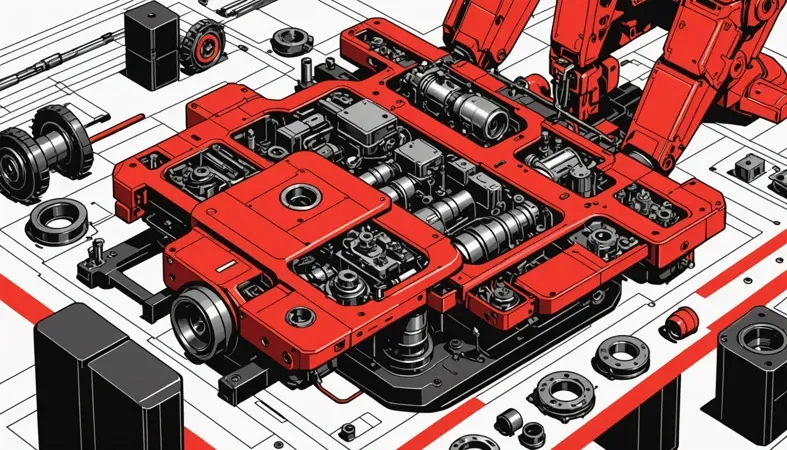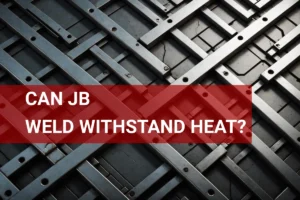Can You Drill and Tap JB Weld? Answers and Steps
Published on: June 9, 2025 | Last modified: March 4, 2025
By: Mark Carter
JB Weld is a strong epoxy adhesive designed for metal, wood, and more. It creates a permanent bond that’s tough as nails.
You may be wondering can you drill and tap jb weld? This question is vital, especially if you need a permanent fixed joint. In my experience, understanding how JB Weld holds up under different stresses can save you time and frustration later.
In this guide, I’ll cover what JB Weld is, different types, preparation steps, safety tips, and methods for drilling and tapping it. I’ll also look at factors affecting your success, common issues, and advanced care tips. We’ll dive deep into whether you can thread JB Weld and what alternatives exist.
Contents
- Can You Drill and Tap JB Weld?
- What is JB Weld?
- Types Of JB Weld
- Prerequisites
- Safety Tips
- Steps to Drill and Tap JB Weld
- Types Of Methods for Drilling and Tapping JB Weld
- Factors Affecting JB Weld Drilling and Tapping
- What You Need to Know About Threading JB Weld
- Common Issues
- Advantages Of Using JB Weld
- Typical Applications Of JB Weld
- What Are the Alternatives to Drilling and Tapping JB Weld?
- Frequently Asked Questions (FAQs)
- Conclusion
- References
Can You Drill and Tap JB Weld?
Yes, you can drill and tap JB Weld, but it’s tricky. JB Weld hardens like metal, making drilling tough. For best results, wait 24 hours to cure, then use a sharp drill bit and proper tapping tools.
What is JB Weld?
JB Weld is a strong epoxy adhesive designed to bond metals, plastics, and other surfaces. It cures to a Rockwell hardness of over 70, making it tougher than many glues. With a tensile strength of over 3,000 psi (20.7 Mpa), this adhesive can withstand significant pressure. Its set time is about 4 to 6 hours, resulting in a heat-resistant bond up to 550°F (287°C).
You might wonder, can you drill and tap JB Weld? In my experience, its hardness makes drilling tricky but possible. You’ll need the right bit, or your work could become frustrating.
While restoring a vintage car, JB Weld was essential for patching a crack in the exhaust manifold. I debated whether I could easily insert a screw into JB Weld, as I wanted to secure additional supporting brackets. Ultimately, drilling took patience, but JB Weld’s strength ensured everything held when the work was finished.
Types Of JB Weld
What types of JB Weld should you know about?
-
Standard JB Weld
This classic epoxy adhesive is super strong and durable. You can drill and tap it easily after it fully cures. Let it cure for at least 24 hours (Often Longer in Cool Conditions), then use a metal drill bit to make your desired hole before threading it with a tap for screws.
-
JB Quick Weld
This type sets quickly, within 4 to 6 minutes. While it’s fast, it’s not ideal for heavy-duty drilling and tapping. Wait for a full cure of 1 hour at room temperature before using a sharp drill bit.
-
JB Marine Weld
Designed for wet and submerged applications, this type is tough and waterproof. You can drill and tap it effectively. Ensure it cures for a full 24 hours, then drill with a sturdy metal bit before tapping it for screws.
-
JB Kwik Plastic Weld
This kind works well for plastic surfaces, providing a solid bond. However, tapping isn’t recommended due to its plastic nature. If you need to drill, let it cure for 15 minutes and use a small drill bit to avoid cracking the plastic.
-
JB High-temperature Weld
This variant withstands heat up to 600°F (316°C). You can drill and tap it with caution. For best results, let it cure for 4 to 6 hours and use a high-speed bit for drilling to maintain its integrity without cracking.
You should now have a good understanding of the various JB Weld types. In the next part, we’ll discuss the necessary prerequisites.

Prerequisites
What do you need to prepare for drilling and tapping JB Weld?
- Drill Bit: Choose a high-speed steel bit, like the DeWALT DW1240. It’s needed to penetrate the cured JB Weld effectively.
- Tapping Tool: Get a tap set, such as the Irwin Hanson 49716. It’s necessary for creating threads in the JB Weld for screws.
- Thread Locking Adhesive: Use Loctite Blue 242. This adhesive secures screws firmly after you tap the JB Weld.
- Drill Press or Hand Drill: A reliable tool, like the Black+Decker GCO1200C, is essential for precise drilling and tapping.
That covers the necessary prerequisites for understanding the topic. Let’s now take a look at important safety tips.
Safety Tips
Let’s quickly cover essential precautions for drilling and tapping JB Weld.
- Wear protective gear: Safety goggles and gloves shield you from debris. I recommend using proper safety goggles like 3M Virtua 2873.
- Check for solid cure: Ensure JB Weld has cured for at least 15-24 hours; this keeps it durable for tapping.
- Use proper drill bit: Choose carbide bits for efficient drilling; brands like Milwaukee or DEWALT make the process smoother.
- Control drill speed: Use a low speed of ~500 RPM to prevent overheating and avoid melting the adhesive.
Remember, following these precautions can save you headaches. Stay safe!
We covered safety tips and precautions here. Next, we will cover the steps for drilling and tapping JB Weld.
Steps to Drill and Tap JB Weld
Now, let’s dive into the exact steps to drill and tap JB Weld for your project.
-
Prepare the JB Weld Surface
Start by cleaning the area. Use a wire brush to remove dirt and debris, then wipe it down with a cloth. Make sure it’s completely dry. You want that surface smooth and clean so the drill bit works effectively.
Let the JB Weld cure for at least 24 hours before drilling. This ensures it sets properly. Rushing this step can lead to uneven holes!
-
Select the Right Drill Bit
Choose a sharp drill bit suitable for drilling into faux metal. A titanium or cobalt bit is ideal. The bit size should match your screw—if you’re using a 6-32 screw, for instance, use a #36 bit (2.3 Mm).
Tip: Don’t start with a larger bit. Begin small and increase size as needed. Precision is key to avoid weak threads!
-
Drill Into the JB Weld
Now, it’s time to drill! Set your drill to a low speed to avoid overheating. Apply gentle pressure; excessive force can crack the JB Weld. Drill straight down about 0.25 inches (6 Mm) deep for most screws. The precision required in tasks like these parallels the skill demanded in B-pressure welding techniques.
If it feels too tough, back off! Clean your drill bit regularly to maintain effectiveness. Slow and steady wins the race here.
-
Tap the Hole for Threads
After drilling, it’s time to tap the hole for threads. Get a tap that matches your screw size. For a 6-32 screw, you’ll need a 6-32 tap. Insert the tap straight into the hole.
Turn the tap slowly and don’t force it—this can ruin the threads. Go in about 0.25 inches (6 Mm), back it out, clear the debris, and repeat until the hole’s fully threaded. Patience is crucial here—don’t rush!
-
Install the Screw
After tapping, install your screw. Ensure it fits snugly; it shouldn’t wobble. Use a wrench to tighten it gently—over-tightening can crack the JB Weld.
This final step will hold everything in place well if done correctly. Remember, finding that sweet spot is vital to avoid future complications!
You should now have a good understanding of drilling and tapping JB Weld. In the next part, we’ll discuss different methods for these processes.
Types Of Methods for Drilling and Tapping JB Weld
Let’s explore various methods for working with JB Weld, covering hand drilling techniques, power drill usage, tapping tools, threading techniques, and cooling methods.
-
Hand Drilling Techniques
A manual hand drill is effective for drilling JB Weld. It offers precision and better control, especially in tight spaces. However, it requires more effort than power tools.
-
Power Drill Usage
A power drill excels in speed when drilling into JB Weld. Use a drill bit designed for hardened materials, with a speed of about 1,000 to 1,500 RPM for optimal performance. I prefer power drills for larger projects to save time.
-
Tapping Tools Overview
Tapping tools create internal threads in JB Weld. Taps come in various sizes; a standard tap size for a basic screw is usually between 1/4 inch (6.35 Mm) and 3/8 inch (9.53 Mm). Match the screw size for an effective fit!
-
Threading Techniques
Threading JB Weld requires finesse. Use a tap and die set for clean threads. Apply light pressure and use cutting fluid to prolong tool life.
-
Cooling Methods for High-temperature Applications
When using heat with JB Weld, cooling methods are essential. Water or specialized cooling liquids can prevent cracking and ensure bond integrity. Cooling below 50°C (122°F) helps maintain strength during the process. If you need to apply similar techniques with thin metal, explore these methods for welding thin metal effectively.
Factors Affecting JB Weld Drilling and Tapping
What factors determine if you can drill and tap JB Weld effectively?
-
Ambient Temperature
JB Weld cures best between 24°C and 38°C (75°F to 100°F). Cooler temperatures slow curing time, making drilling harder.
-
Cure Time
Curing typically takes 4-6 hours for handling and 15-24 hours for a full cure. Drilling too soon risks damaging the bond.
-
Weld Thickness
Thicker JB Weld can be stronger and better withstands drilling stress, especially in joint applications.
-
Drill Bit Quality
Your choice of drill bit matters. High-speed steel (HSS) bits work best, providing better cutting efficiency and reducing the chance of cracking.
-
Type Of Material Joined
The materials you’re bonding can affect drilling. Metal joints typically handle drilling stress better than plastic or ceramic, which may crack easily.
What You Need to Know About Threading JB Weld
Threading JB Weld is an art as much as it is a science. To do it effectively, you need to understand the specific aspects of JB Weld that impact threading.
Key Factors for Threading JB Weld
-
Hardness
JB Weld reaches a hardness of about 70 on the Rockwell scale. This means you’ll need durable tools, like high-speed steel taps that can endure tough materials.
-
Cure Time
Let the JB Weld cure for at least 15-24 hours for optimal results. Drilling or tapping sooner can lead to stripped threads or cracking.
-
Temperature Resistance
This epoxy can withstand temperatures up to 550°F (287°C). However, keep in mind that extreme heat can weaken the bond if exposed continuously.
-
Application Thickness
A thicker application usually holds better. Aim for at least 1-2 mm (0.04-0.08 inches) of JB Weld to provide a good substrate for threading.
Threading JB Weld: Dos and Don’ts
| Dos | Don’ts |
|---|---|
| Use a sharp tap that matches your screw size. | Don’t force the tap; if it resists, back off and check the alignment. |
| Drill a pilot hole before tapping to enhance accuracy. | Don’t skip cleaning debris from the hole before tapping. |
| Apply cutting oil for smoother threading. | Don’t drill or tap too fast; maintain control and pressure. |
| Test the fit of your screws after tapping. | Don’t ignore any signs of resistance when screwing in; this could indicate weak threads. |
Common Issues
Let’s examine specific problems related to JB Weld.
-
Insufficient Cure Time
JB Weld requires 4 to 6 hours to set and 15 to 24 hours to cure. If it isn’t given enough time, there’ll be weak joints. Check the curing time; if it’s too soft, let it sit longer.
-
Improper Surface Preparation
JB Weld needs clean, roughened surfaces for a strong bond. I’ve experienced this: greasy or smooth spots can weaken connections. Sand, clean, and let it dry before applying.
-
Incorrect Drill Size
Drilling JB Weld with too large a bit can create weak points. Use bits that match the diameter of your fasteners carefully.
-
Excessive Heat Generation
JB Weld can weaken if exposed to temperatures above 300°F (150°C). Monitor operating temperatures to prevent breakdown.
-
Weak Bonding in High-stress Areas
JB Weld isn’t suitable for very high-stress applications. If it fails, consider using mechanical fasteners instead. Inspect regular load points and reinforce as needed.
Advantages Of Using JB Weld
The main benefit of JB Weld is its strong bond. When I fixed my car’s exhaust, it held everything together securely.
Additionally, JB Weld is versatile, durable, and resistant to heat and chemicals. It’s easy to apply, sets quickly, and effectively fills gaps.
Typical Applications Of JB Weld
I’ve seen people use JB Weld for various repairs, including:
- Automotive Repair: JB Weld repairs cracked engine blocks due to its high heat resistance. It’s popular for its strong bond that withstands extreme conditions.
- Piping Repairs: Use JB Weld for leaks in water pipes. Its pressure resistance makes it a quick fix before permanent repairs.
- Home Appliances: People often use JB Weld to fix broken parts in dishwashers. It’s a durable alternative to replacement parts.
- Metal Art Creation: Artists use JB Weld to attach metal rods seamlessly. It provides creative freedom and secure joints, making it a favorite for mixed media projects.

What Are the Alternatives to Drilling and Tapping JB Weld?
If you’re looking for alternatives to achieve a similar result, consider using heavy-duty epoxy products, such as J-B Weld Steel Reinforced Epoxy. This offers robust bonding, even without drilling or tapping, and is suitable for metals, plastics, and more. From my unique perspective, I’ve noticed that these products can save time and reduce the risk of damaging the joint.
An option worth exploring is the JB Weld Thread Repair Kit. It’s especially handy when you need a threaded hole without the potential hassle of drilling into cured JB Weld. These approaches work well for different projects and can yield similar, if not better, results while offering easier application methods. To further understand the various welding positions that could affect your choice of welding techniques, explore this introduction to 1F, 2F, 3F, and 4F welding.
Frequently Asked Questions (FAQs)
Now let us look at some questions I typically get asked.
Can You Tap a Thread Into J-B Weld?
Yes, you can tap a thread into J-B Weld. Tapping creates a threaded hole, which means a strong bond is essential to avoid breakage. Keep in mind that once J-B Weld cures, it’s very hard—approximately 40,000 psi—ensuring threads hold well under stress.
What Epoxy Can Be Drilled and Tapped?
Some epoxies can be drilled and tapped, including high-strength ones like J-B Weld. These epoxy types typically achieve strengths over 10,000 psi and are designed for structural applications, making them reliable for added threaded connections when cured.
Can You Drill Into J-B Weld?
Yes, you can drill into J-B Weld once it’s fully cured. Drilling after curing gives you a hard surface to work with, reaching hardness levels close to steel. Ensure you’re using a high-speed drill bit to avoid cracking the epoxy during the process.
Can J-B Weld Be Tapped?
Yes, J-B Weld can be tapped. Since J-B Weld cures into a dense, strong material, it can effectively hold threads, making it possible to securely fasten with screws. Always allow at least 15 hours for proper curing. In more challenging environments, such as submerged or under high pressure, weld stability is crucial. For a deeper understanding of the risks associated with this specialized field, see how dangerous is underwater welding.
Can You Screw Into J-B Weld?
Yes, you can screw into J-B Weld. Once fully cured, it’s capable of holding screws firmly, offering a tight connection due to its high tensile strength. Average tensile strength of 3,000 psi provides a reliable grip.
Conclusion
We’ve reached the end, and I appreciate you sticking around. We covered what JB Weld is, its types, the prerequisites, and the steps needed to drill and tap it. We also touched on safety tips, methods for drilling and tapping, key factors affecting this process, common issues, aftercare, and even alternatives to JB Weld.
So, can you drill and tap JB Weld? In simple terms, yes, you can. Hopefully, I was able to impart some of my experience: with proper techniques and patience—along with what we discussed about safety methods—you can successfully drill and tap JB Weld for various applications.
If you’re looking to broaden your understanding even further, consider visiting What is Welding for more insights.
References
- ISO. (2017). ISO 3834: Quality Requirements for Fusion Welding of Metallic Materials. Geneva, Switzerland: ISO.
- National Fire Protection Association. (2022). NFPA 51B: Standard for Fire Prevention During Welding, Cutting, and Other Hot Work. Quincy, MA: NFPA.
- Occupational Safety and Health Administration (OSHA): Welding, Cutting, and Brazing: https://www.osha.gov/welding-cutting-brazing
Mark is a skilled welding engineer specializing in advanced metal joining technologies and process design. With a formal education in welding engineering and a background rooted in practical experience, Mark bridges the gap between theory and application. He is passionate about making technical concepts accessible, empowering welders to embrace innovation while mastering essential skills. Mark combines his scientific expertise with a commitment to supporting the welding community alongside his uncle, Joe.
Art, DIY Projects, Drilling, Epoxy Adhesive, Jb Weld, Metal Repair, Protective Gear, Safety Tips, Tapping, Welding, Welding Techniques







